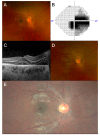Bartonella Neuroretinitis with Initial Seronegativity and an Absent Macular Star: A Case Report and Literature Review
- PMID: 39195624
- PMCID: PMC11359919
- DOI: 10.3390/tropicalmed9080186
Bartonella Neuroretinitis with Initial Seronegativity and an Absent Macular Star: A Case Report and Literature Review
Abstract
Cat-scratch disease (CSD) is an infectious disease caused by Bartonella henselae, presenting with fever and lymphadenopathy following contact with felines. The ocular manifestations include neuroretinitis, characterised by optic nerve swelling and a macular star. Case Presentation: We discuss a case of neuroretinitis that presented atypically, without a macular star. There was an initial suspicion of Bartonella, but the serology was negative. Our patient was eventually empirically treated for infective neuroretinitis based on a positive contact history (recently scratched by one of his three pet cats). There was progression to a macular star upon serial dilated fundus examination, and the repeated serology one week after symptom onset showed rising titres, supporting a diagnosis of CSD. Conclusions: A judicious review of systems, repeat assays, serial dilated fundus examination, and early ophthalmic evaluation are useful in cases of suspected neuroretinitis, remaining an important differential in the evaluation of sudden-onset painless vision loss and unilateral disc swelling.
Keywords: Bartonella henselae; cat-scratch disease; neuroretinitis.
Conflict of interest statement
The authors have no competing interests to declare.
Figures

References
Publication types
LinkOut - more resources
Full Text Sources
Miscellaneous

